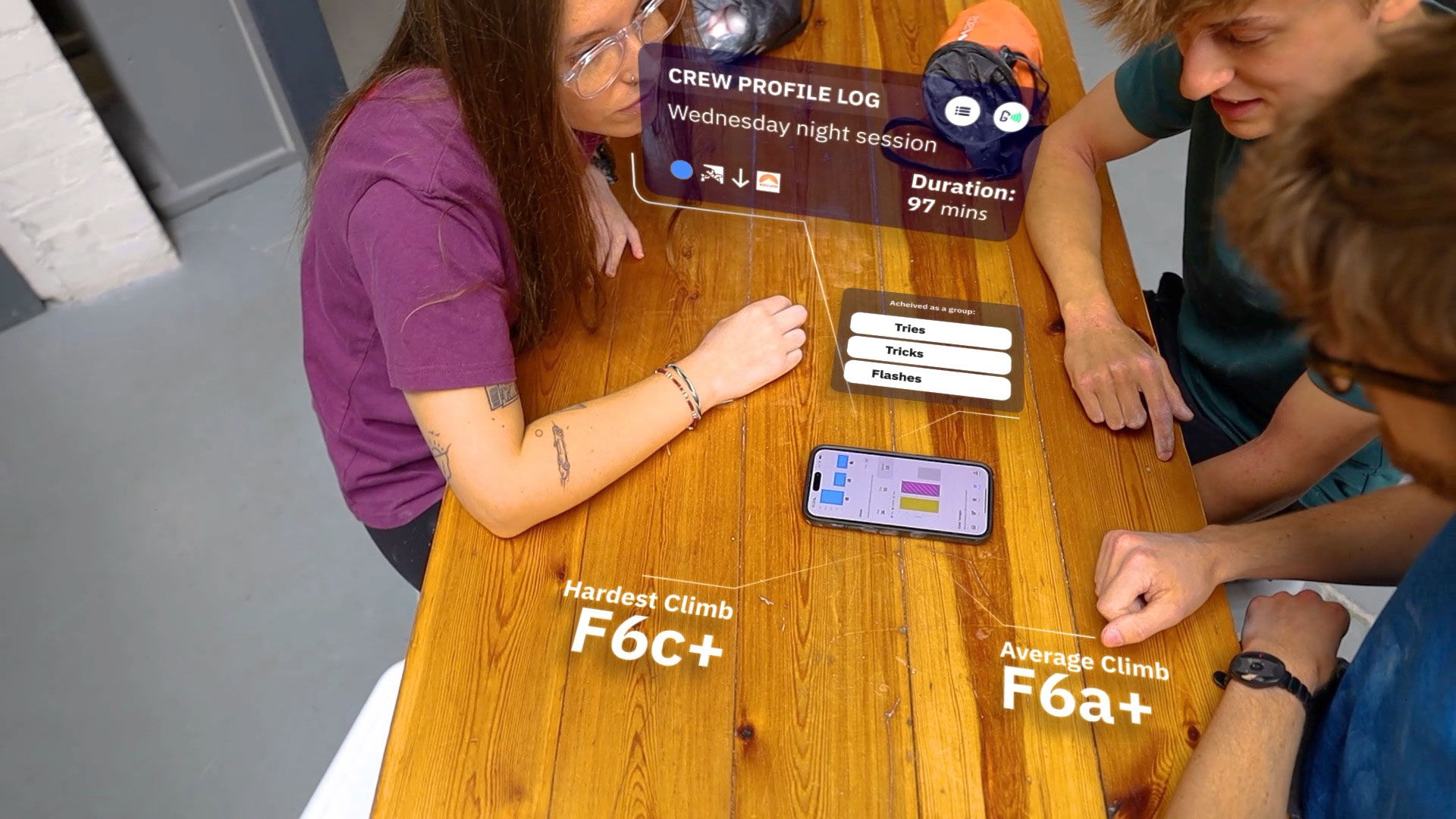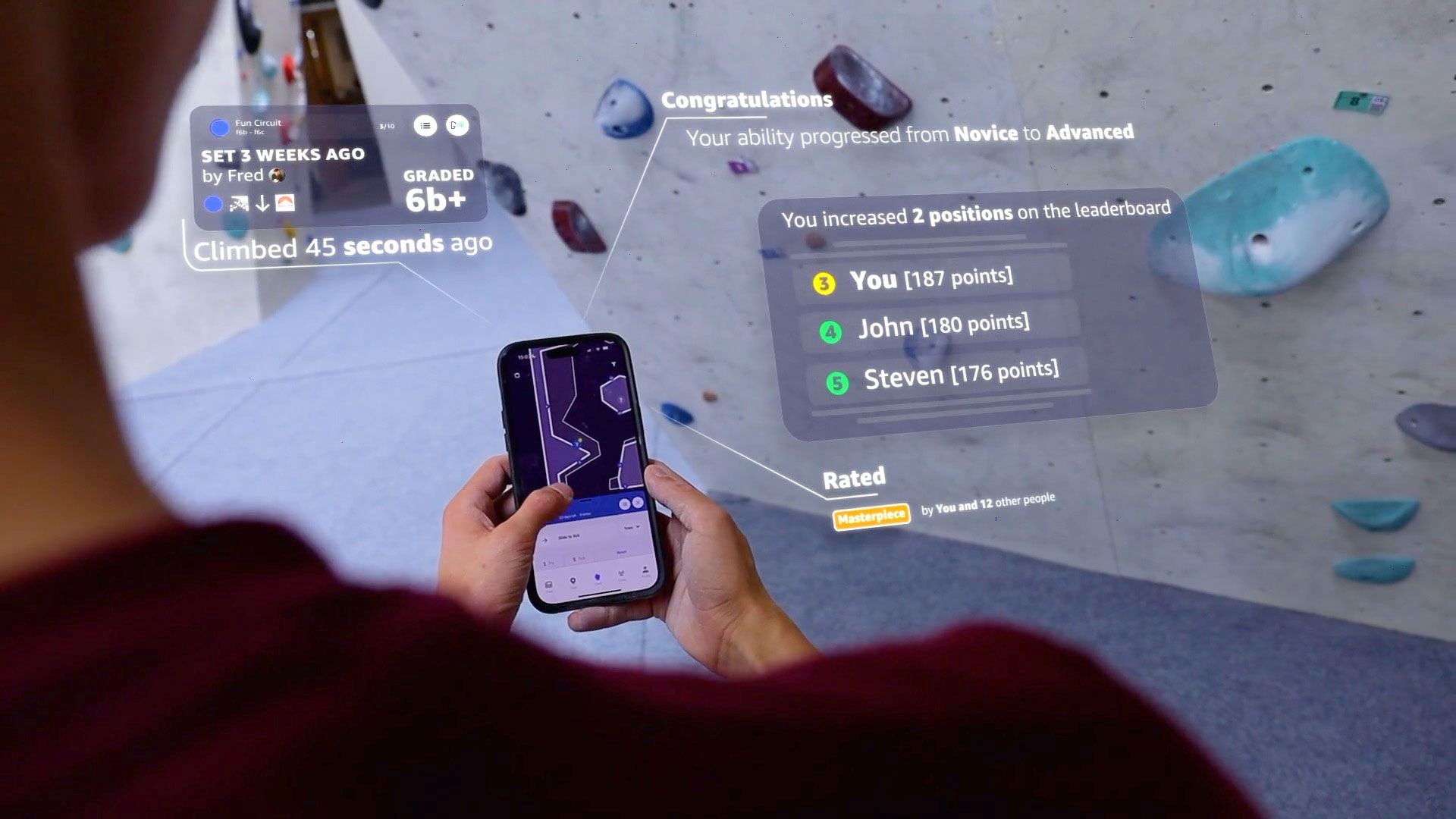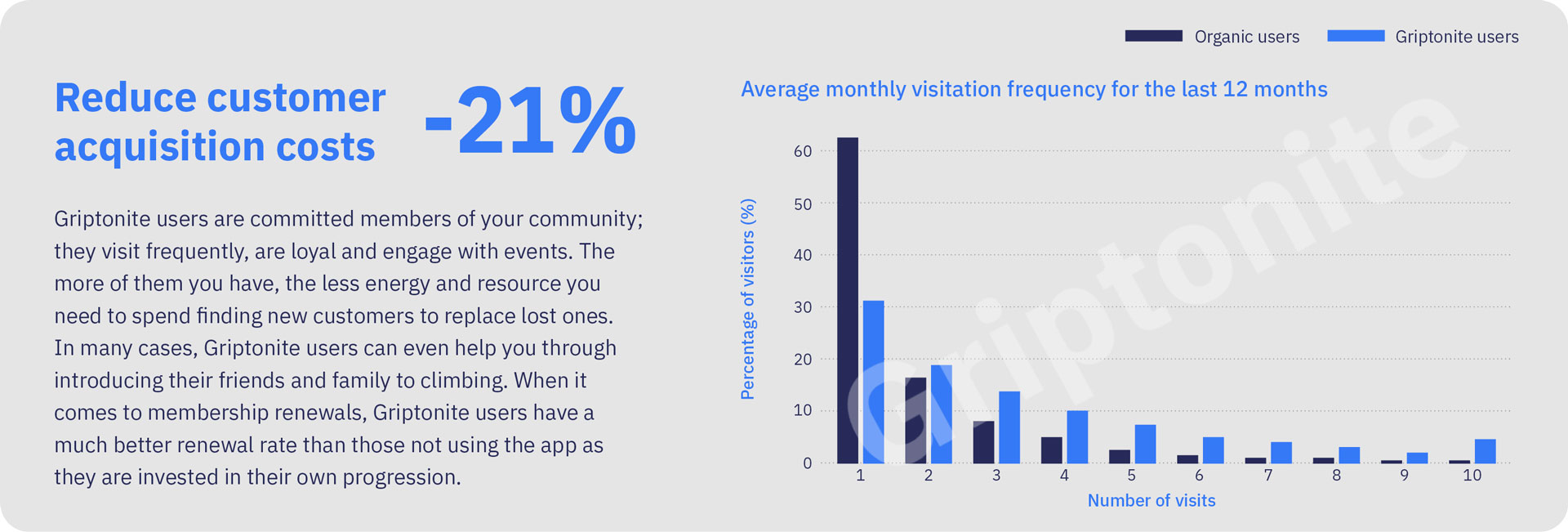
Authored by Dr. Cassim Ladha (founder and CEO of Griptonite)
The terms retention and churn have been circulated for numerous years in our industry. In 2019, before COVID, I remember sitting in on presentations at an annual tradeshow and listening to gym survey figures being presented. Churn and retention were headliners. Although the presentations were meant to shed light on these topics, they left me with more questions than I went in with. Usually I am fine with numbers (I have a PhD and 15 years of experience wrestling complex math), but I found these presentations to be confusing. On one hand, there was a scary message of “watch out for these two monsters that will eat your business.” On the other, there was a clear message that there had “never been a more interesting time to open an indoor climbing gym” than now. I can only imagine how gym owners without a technical background must have felt hearing these messages, with no clear, actionable steps on how to proceed.
Fast forward a few years: It’s now 2024 and I am the CEO of Griptonite, an IT company holding one of the largest repositories of indoor climbing data on the planet. In the Griptonite platform, over 500K climb attempts from users all around the globe are logged each month, and over 600 amateur competitions are organized per year. I have also had conversations with hundreds of gym owners from 17 countries, and while a lot of these calls are about Griptonite, I always take time to understand the idiosyncrasies and nuances for each gym.
Sitting back and reflecting on this data, I think I still have a bee in my bonnet about this whole churn/retention issue, and this article is a step toward highlighting what I have uncovered from my own endeavors to understand it. Below are two key lessons and tips from my research that gym operators anywhere can try today to decrease churn and increase retention at their gym.
Behind the Data
Before diving in, let’s clarify what we mean by Churn and Retention. Churn is the term given to the continuous loss of customers over time; it doesn’t specify if the customers are longtime members, new ones or first-time visitors. Retention is a business’s effectiveness at encouraging customers to keep coming back. In business circles, we often talk about Customer Lifetime Value (CLV), as well. However, the primary focus I chose for my research was Visitation Frequency. Why? Because the more times customers visit the gym, the more reason they have to purchase a pass. This is a far more tangible key performance indicator (KPI) than CLV or retention, I would argue.
As for the research, we began by collecting 12 months of data from a mix of seven gyms in the north of England—some in university towns, some roped, some bouldering, some mixed. This data I would consider to be “ground truth,” since it’s from the cashier’s desk—collected from exports of point-of-sales (POS) data—and it includes anonymous info about customer purchasing methods, demographics, etc.
Next, thirty interviews were made at three of these gyms. We structured the conversations around a questionnaire, but we also let the conversations ebb and flow freely.
Finally, we gathered hard data collected from our app. There were around 500K attempts logged each month by some 28K users. We were able to “marry up” our data with the POS data and track time spent at each wall across climbing activities, abilities and demographics.
My questions to begin with were relatively simple enough: “Where are the biggest low hanging fruits for gyms, financially?” and “What differentiates successful and not-so-successful gyms?”

Lesson #1: First Impressions Are Everything
When I started to dig through the data, it became clear quite quickly that a vast majority of first-time users were not coming back to the gym a second time. This number seemed to swamp the drop-off rate after other numbers of visits. It was in-line with figures I’ve seen in climbing industry reports, but seeing it for myself made me think of two questions: “who?” and “why?” The second thing that was blatantly obvious was, roughly speaking, if a customer did come back a second time, they were twice as likely to come a third.
For the “who?” part, my colleagues and I scoured the datasets trying to make correlations and, in the end, concluded that no particular demographic stood out. The questionnaire data told individual stories, but non that translated into a trend, as far as we could discern.
The “why?” part, though, was quite illuminating! A cluster analysis helped us pick out 6 main reasons why first-timers were not returning to the gym:
- Embarrassment
- Expectations not met
- Confusion
- Value for money
- Not what expected
- Didn’t enjoy it
This is where the questionnaire data came into its own. Further picking these points apart, we found something we didn’t expect in the data: the decision to return a second time or not tended to happen in the first 30 minutes of entering!
Think about that for a moment…A person walks into a gym expecting to partake in a new sport for the first time. How are they greeted at your gym? Talking to many of our gym clients around the world, I know the story has often looked something like:
- Please read and accept this long legal document (that mentions the words death and injury).
- Please pay money (then more money for rental equipment).
- Please wear these weird-looking, very-tight shoes that you don’t know who else has worn.
- Walk around and see everyone else looking like they know what to do.
- Get told several things that you shouldn’t do (jump down, climb under people, leave water bottles and phones around, etc.).
- Get told to “give it a try,” possibly in front of several other people or even your date, whom you’re trying to impress!
Sound familiar? The truth is, as humans we get a kick out of accomplishing something outside of our comfort zone; that’s part of the attraction of our sport. But there is a point where we will give up and call it a bad decision. Out of self-preservation, most people WILL give up (usually mentally first) before they feel things would get too out of hand. All this decision-making boils down to a huge pressure of getting a “pay back” from the first few climbs that makes it all worthwhile. If the pay back isn’t up to par, the game is up. Bye bye, potential member.

Tip #1: Invest in the First-Time Experience
What these findings emphasize is the importance of focusing hard on making the first-time visit positive, from the moment a customer walks through the door. Things like a free chalk or shoe rental can help reduce negative feelings and apprehension before a customer tries climbing for the first time. Including a free post-climb coffee can help set the tone, as well. The options are endless, but the point is simple: A negative first-time experience is likely to have a much harsher consequence than these small costs to a gym, so start off on the right foot.
In terms of the actual climbing experience, small adjustments can go a long way there, as well. Climbing is hard, but building a specific “Warm Up” circuit or auto-belay climb is a way to give that first sense of accomplishment. These climbs can help customers build confidence to try something a little more challenging next, and it’s also a safety net they can return to.
When it comes to labels of climbing areas and climbs, we found from the data that names ARE important. Stay away from labeling an area as a “Kids Zone,” since it can create a negative stigma around that part of the gym; “Warm Up” zone is preferred. Remember, conversations about specific indoor climbs go on outside the gym, too, just like they do for rock climbs. After a session, customers may want to tell their climbing partners about their battle with a “blue V3 in the corner.” Make their life easier by giving wall sections and climbs interesting, quirky names they’ll remember. In our app, we find that climbs with route names get more engagement than those with just a grade/color description. These names help you communicate new sets, too.
Lastly, although the first 30 minutes can be the most crucial decision-making period for a customer, it’s not the only one, and there are things gyms can do to try and buck that trend. During and after a session, be sure to check in with customers with a “how are things going?” question. Doing so maintains a connection and creates space for customers to recall positive emotions and achievements and make a stronger association to the feelings they can only get when going climbing. Another idea, before customers walk out the door, is a “see you next Friday?” question from the desk staff. A “sure thing!” response asserts a basic commitment they can feel accountable to. Even better if their friends overhear it and help them stick to that goal.
Remember, some level of churn is natural for any business. The moment a customer walks out the door could be the last you see of them. Even if they don’t come back because they genuinely don’t like it, the next best thing is they tell a positive story about the gym and encourage others to give it a try.

Lesson #2: Putting Yourself in Their Shoes Can Help
The next bit of behavior I started to understand from the data was the user behavior around buying into memberships. What motivates this decision, and when does the decision point come? To begin with, I took a step back and looked at how people paid to get into the gym across their first ten visits. There were generally three options: a day pass, a prepaid punch card, or a membership (annual or monthly). What I noticed in our dataset was that there was almost no conversion from a day pass into a punch card or membership within the first ten visits.
I was keen to understand why, of course. Digging a little deeper and using our questionnaires, I began to understand that a membership, or any sort of prepayment, represents a commitment or investment for the customer. As with any investment, we expect some sort of pay off, and the obvious one here is a cash saving from not having to pay full entry every time. The more times a customer visits the gym, the bigger the cash savings. However, what I also saw is that within the first ten visits, the major purchase that new climbers invest in is climbing shoes. Since the cost of new climbing shoes can represent a significant chunk of one’s paycheck, the decision to buy a membership is put off to the next month.
Fast forward a month and put yourself in the new climber’s (new) shoes. They are really getting going now and have been making use of their first equipment purchase. They just received another paycheck, too, and want to go climbing more often! It is pretty clear there has never been a better time to place a special offer on memberships, but most gyms we’ve seen don’t. As a result, new climbers who take time to think about the benefits of a membership are faced with a complex set of mental math standing in their way. The result is obvious in the conversion data!

Tip #2: Offer Personalized Deals to Repeat Customers
There is of course another way this scenario can play out, and many industries are already ahead of ours on it: targeted, personalized offers. What if we presented a personalized membership offer to new climbers based on their actual visitation over the last two months? Remember, in this period they have bought their new climbing shoes and have been making great use of them. Their motivation for climbing is high, and they are still early on the progression curve where gains come after every visit. We put this idea into practice, and the results were astounding. Even a very plainly presented offer converted well.
When we took special care with how that offer was presented—added some persuasive wording and personalization and presented the offer at a key decision point on the customer’s journey—you can guess which direction the conversion rate went. So, when you present membership offers to new climbers—and whenever you communicate with customers—make sure that communication is meaningful, personal, and adds value.
In terms of adding value, remember that climbing attracts many people because of its personality and alt-culture. Gen-Z customer values, especially, orbit around authenticity and community. So, with things like membership deals, try to bundle them with access to a group yoga or coaching session or a “bring a friend” offer.
Remember, the goal is long-term customers, and achieving that goal can take a little bit of investment.

Key Results
In this case study, of course we already actioned the lessons and tips above and put them into an elegant solution! To cut to the chase, we can report that through the “Griptonite effect” we:
- Cut first-time customer churn from 66% to 32%.
- Improved membership and punch card sales by 13%.
- Reduced customer acquisition costs by 21%.
- Lengthened the lifetime of being a customer by 9%.
- Improved conversion to a membership or punch card.
In part, we were able to make these improvements by leveraging the psych of existing customers and incentivising them to remain engaged at the gym and bring their friends. There are many hacks to doing so without software, which I intend to write about in a follow-up article.

As a software company, our product is never finished! We constantly make updates and improvements and strive to do so in a meaningful way that delivers value to our clients. Sometimes delivering that value means helping clients make time-saving tweaks to workflows, and sometimes it means making tools that help them better their business. In both cases, it’s useful to be able to talk about the effect and value our product can bring to their business.
If you want to learn more about how the Griptonite platform works, the best way is to get in touch for a demo. Give me a shout at cas@griptonite.io and we can have a call! We will also be onsite at the upcoming CWA Summit in Portland, so be sure to stop by booth #1003!
About the Author

Dr. Cassim Ladha (PhD) brings over 15 years of experience as a research scientist to the climbing industry. His expertise is in data analysis, machine learning, and complex behavioral and human movement modeling. He moved away from academia and founded Griptonite in 2018.
This story was paid for by the sponsor and does not necessarily represent the views of the Climbing Business Journal editorial team.

Griptonite is a data-driven climbing software company serving gyms, climbers and brands worldwide. The team focuses on reducing visitor churn, increasing visitation, and designing software tools that reduce the time burden on operational and setting staff. Give Griptonite a try today.







